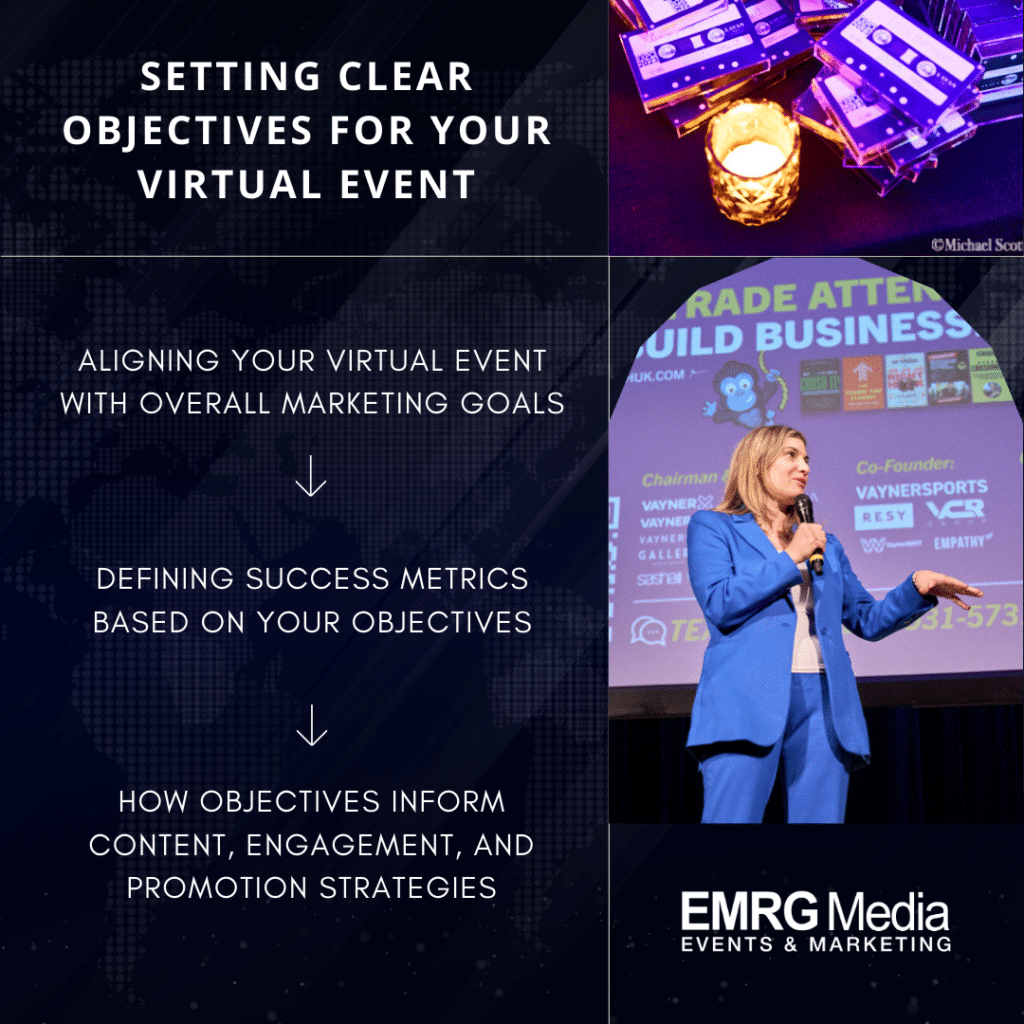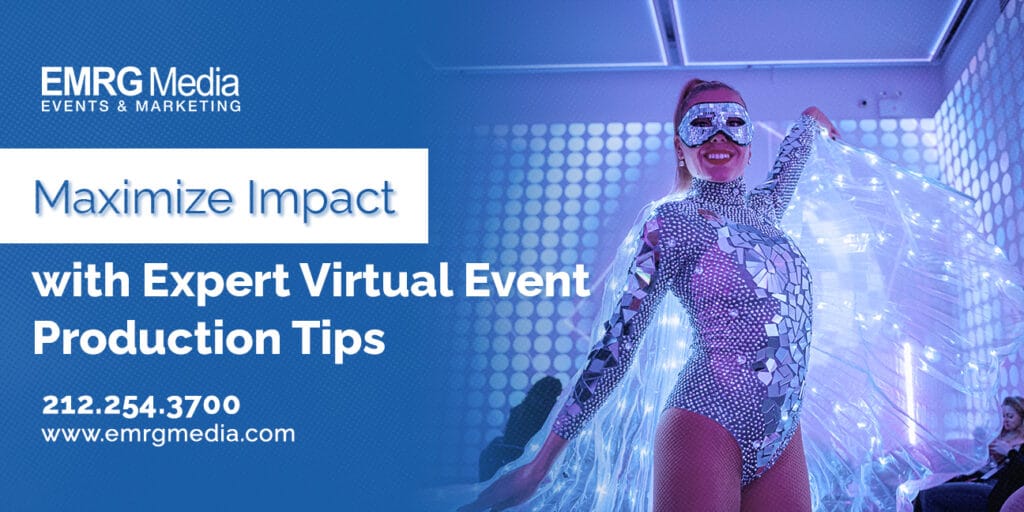With digital advancements happening faster than ever before, the way we hold events and conferences has changed dramatically. Virtual Event Production has emerged as a key component of successful digital gatherings, combining the essence of live events with the flexibility and reach of online platforms.
This transformation, driven by technological advancements and a global shift in work and communication patterns, emphasizes the importance of high-quality production in capturing and engaging audiences worldwide.
Professional virtual event production ensures that content is delivered smoothly, maximized engagement, and the overall experience is polished and professional.
This guide unveils expert tips and strategies to elevate your virtual event production. Whether you’re planning a webinar, an online conference, or any other digital gathering, these insights will empower you to craft an experience that resonates with your audience and maximizes your event’s impact.
Ready to turn your event vision into a reality? Contact EMRG Media and let our team of experts guide you through a seamless and unforgettable event planning experience in New York City.
Table Of Contents:
- Understanding Virtual Event Production
- Setting Clear Objectives for Your Virtual Event
- Choosing the Right Virtual Event Platform
- Crafting Engaging Virtual Event Content
- Optimizing Your Virtual Event Technology Stack
- Fostering Audience Engagement in a Virtual Environment
- Promoting Your Virtual Event for Maximum Reach
- FAQs about Virtual Event Production
- Unlocking Success: Beyond the Basics of Virtual Event Production
Understanding Virtual Event Production
In today’s fast-paced world, where technology reigns supreme, virtual event production has emerged as a vital tool for corporations, brands, charities, and individuals aiming to connect with their audience from anywhere globally.
EMRG Media is at the forefront of transforming traditional events into dynamic virtual experiences in New York City. Our expertise lies in adapting to this digital shift and excelling in it by providing creative solutions that ensure your event is memorable and engaging.
The Essence of Virtual Events
Virtual events transcend geographical limitations, allowing you to reach a global audience without the constraints of physical venues. These online gatherings can range from webinars and conferences to live concerts and product launches.
The key advantage is accessibility; attendees can join from the comfort of their homes or offices, making it easier to boost attendance rates and engagement levels.
Key Components of Successful Virtual Event Production
- Creative Content: At EMRG Media, we believe content is king. Crafting compelling narratives and presentations that captivate your audience is crucial.
- User-Friendly Platform Selection: Choosing the right platform that offers seamless navigation for your attendees ensures a positive experience. Whether it’s through Zoom meetings or more sophisticated platforms like Hopin or Remo.co., compatibility with various devices is paramount.
- Interactive Elements: Incorporating interactive features such as Q&A sessions, polls, and chat rooms enhances participant engagement by making them feel involved rather than mere spectators. Eventbrite’s guide on virtual event ideas showcases how interactivity plays a pivotal role in successful events.
- Tech Support: A dedicated technical support team ensures any issues are swiftly addressed, minimizing disruptions during your event.
Navigating these components effectively requires expertise—a trait EMRG Media prides itself on possessing.
With our innovative approach towards virtual event production combined with our dedication towards excellence; we guarantee not just an event but an unforgettable experience tailored perfectly according to your needs.
Discover how we’re redefining corporate engagements through our comprehensive planning services—your journey towards impactful digital connections starts here!
Setting Clear Objectives for Your Virtual Event
Setting clear, actionable objectives begins the process of creating a successful virtual event. These objectives guide the planning process and serve as benchmarks for measuring the event’s success.
Understanding what you aim to achieve is crucial, whether you’re educating your audience, generating leads, or building community.
Aligning Your Virtual Event with Overall Marketing Goals
Your virtual event should be a strategic component of your broader marketing efforts. Start by reviewing your overall marketing goals and identifying how your event can contribute to them.
For instance, if your goal is to increase brand awareness, your event should showcase your brand’s values and strengths. Similarly, if your aim is lead generation, consider how the event can provide valuable content that encourages participants to engage further with your brand.
Defining Success Metrics Based on Your Objectives
Once your objectives are aligned with your marketing goals, it’s essential to define how success will look. Will it be measured by the number of registrations, attendee engagement rates, or the quality of leads generated?
Setting these metrics early allows you to design your event with these goals in mind and provides explicit criteria for post-event evaluation.

How Objectives Inform Content, Engagement, and Promotion Strategies
Your objectives will significantly influence the content you produce, how you engage attendees, and how you promote your event.
For example, if one of your goals is to encourage networking, you’ll want to include features and activities that encourage interaction, such as breakout sessions or networking lounges.
Your content should be relevant and engaging, directly addressing the interests and needs of your target audience. Your promotion strategies should be targeted and personalized, ensuring you reach potential attendees through the most effective channels.
By setting and aligning your objectives with your overall marketing goals, defining clear success metrics, and allowing these objectives to inform your content, engagement, and promotion strategies, you lay a solid foundation for a successful virtual event.
Choosing the Right Virtual Event Platform
Selecting the right platform is critical for the success of your virtual event. It acts as the venue for your digital gathering, shaping the overall experience for your attendees.
The platform you choose should not only support your technical requirements but also enhance the engagement and interaction of your event.
Understanding Your Audience Size and Engagement Needs
Before choosing a platform, it’s vital to clearly understand your audience size and the level of engagement you wish to achieve. Some platforms are better suited for large-scale events with thousands of participants, while others are more appropriate for smaller, more interactive sessions.
Consider the types of engagement you want to facilitate, such as live polling, Q&A sessions, or networking opportunities, and ensure the platform can support these features.
Must-Have Features for a Seamless Virtual Event Experience
A seamless user experience is non-negotiable for virtual events. Essential features include reliable streaming quality, user-friendly interfaces, interactive tools, and robust customer support.
Additionally, the platform should offer customization options to align with your brand and event theme. Accessibility features, such as closed captioning and language translation services, are also important to ensure your event includes all attendees.
Platform Integrations to Streamline Your Workflow
Integrating with other tools and software can significantly enhance the efficiency and effectiveness of your event.
This might include integration with Customer Relationship Management (CRM) systems for registration and attendee tracking, social media for promotion and engagement, and analytics tools for measuring event success.
A platform seamlessly integrating with your existing workflow can save time and reduce the complexity of managing your event.
Crafting Engaging Virtual Event Content
The content of your virtual event captures and retains your attendees’ attention. Crafting informative, relevant, engaging, and interactive content is crucial.
This involves a strategic blend of content formats, presentation techniques, and participation opportunities to cater to diverse attendee preferences.
Variety is Key: Choosing the Right Content Formats
Incorporate a variety of content formats—from keynotes and panel discussions to interactive workshops and live demonstrations—to keep your audience engaged throughout the event.
Mixing live and pre-recorded content can also provide flexibility and diversity, catering to different time zones and schedules. When selecting these formats, consider your event’s details and your target audience’s preferences.
Captivating Your Audience: Tips for Effective Virtual Presentations
Effective virtual presentations emphasize clear communication, engaging storytelling, and visual appeal. Encourage speakers to complement their message with visuals and multimedia for better presentations.
Rehearsals and technical check-ups can help presenters confidently and smoothly deliver their content.
Encouraging Interaction: Q&A Sessions, Polls, and Workshops
Interaction is vital to keeping the virtual audience engaged. Incorporate Q&A sessions, live polls, and interactive workshops to allow attendees to contribute, ask questions, and share their thoughts.
These elements make your event more dynamic and provide valuable feedback and insights from your audience. Strategically planning these interactive segments throughout the event can maintain energy and engagement levels.
Optimizing Your Virtual Event Technology Stack
The technology stack you choose for your virtual event plays a crucial role in its success. From audiovisual equipment to platform integration, the right technology enhances the attendee experience and ensures the event runs smoothly.
Selecting the Right Audio/Visual Equipment for Professional Quality
Investing in high-quality audio and visual equipment is essential for delivering clear, professional content. Good-quality microphones, cameras, and appropriate lighting can drastically improve the presentation quality.
Consider the setup of your presenters and provide guidance or equipment to ensure consistency across presentations without any problems.
Ensuring Seamless Integration Between All Technologies
Seamlessly integrating your technology stack is crucial for a smooth event experience. This includes ensuring compatibility between your event platform, CRM, email marketing tools, social media, and other technologies.
Testing these integrations well before the event can prevent technical issues and ensure a seamless experience for both organizers and attendees.
Benefits of Working with a Technical Expertise Virtual Event Partner
Collaborating with a partner specializing in virtual event production can provide you with the technical expertise and support needed to navigate the complexities of your technology stack.
They can assist with everything from selecting the right equipment to ensuring all technologies work together seamlessly. This partnership can be invaluable in avoiding technical glitches and enhancing the overall quality of your event.
Ready to host a flawless virtual event? Contact EMRG Media today and let our team of experts handle the technical side so you can focus on creating a captivating experience for your audience.
Fostering Audience Engagement in a Virtual Environment
Engaging an audience in a virtual environment presents unique challenges compared to live events. The lack of physical presence demands innovative strategies to capture and maintain attendees’ attention, combat virtual fatigue, and encourage active participation.
Combating Virtual Fatigue: Strategies to Keep Attendees Active
Without the right engagement strategies, virtual fatigue can set in quickly. To combat this, plan shorter sessions with breaks in between, incorporate engaging visuals and interactive content, and use a variety of presentation formats to maintain interest.
To maintain high energy levels, gamification components such as treasure hunts and quizzes can offer a fun and competitive aspect.
Encouraging Participation: Interactive Tools and Activities
To encourage real-time participation, use interactive tools such as live chats, polls, and Q&A sessions. Breakout rooms for smaller group discussions or workshops can foster deeper engagement and allow attendees to connect more personally.
Providing opportunities for attendees to interact with speakers and each other creates a sense of community and involvement.
Building Anticipation: Pre-Event Promotion and Community Building
Building anticipation before the event is crucial for fostering engagement. Use social media, email campaigns, and your event website to tease content, highlight speakers, and share engaging pre-event activities.
Creating a hashtag for your event can encourage attendees to share their thoughts and connect with others. This pre-event buzz boosts registrations and sets the stage for a highly engaged audience.
Promoting Your Virtual Event for Maximum Reach
Effective promotion is critical to attracting a large and relevant audience for your virtual event. A strategic mix of social media, email marketing, influencer partnerships, and compelling event pages can amplify your message and boost registrations.
Leveraging Social Media Platforms to Amplify Your Message
Social media platforms offer a powerful way to reach and engage with potential attendees. Create engaging content highlighting your event’s value, including speaker announcements, session teasers, and user-generated content.
Use targeted ads to reach specific demographics and interests, ensuring your event gets in front of the right audience.
Targeted Email Marketing Campaigns to Reach Your Ideal Audience
Email marketing allows for direct and personalized communication with your audience. Segment your email lists based on interests, past event attendance, and other relevant criteria to tailor your messages.
Craft compelling subject lines and content that convey the benefits of attending your event, encouraging recipients to register.
Partnering with Influencers to Expand Your Reach
Influencers can help extend your event’s reach to new audiences—partner with influencers who align with your event’s theme and audience to promote it through their channels.
This can lend credibility and attract attendees who trust the influencer’s recommendations.
Creating a Compelling Event Website or Landing Page for Registrations
Your event website or landing page is the hub for your promotional efforts. Ensure it’s visually appealing, easy to navigate, and provides all the necessary information at a glance.
Include clear calls-to-action (CTAs) for registration, a detailed agenda, speaker bios, and any other information that would entice someone to attend.
FAQs about Virtual Event Production
What is virtual event production?
Virtual event production involves the creation of online events designed to captivate and engage viewers directly from their screens. This can include webinars, live streams, and interactive meetings.
What are examples of virtual events?
Examples of virtual events can range from webinars and virtual conferences to online workshops and live-streamed concerts.
How do I create a virtual event program?
To create a virtual event program, start by choosing your platform wisely. Then, incorporate engaging content and intersperse interactive sessions throughout. And there you have it – a well-crafted virtual event program.
How much does it cost to have virtual events?
The cost of hosting virtual events can vary significantly. It can range from being almost free to costing thousands of dollars, depending on the technological requirements and the scale of the event.
Unlocking Success: Beyond the Basics of Virtual Event Production
Making a successful virtual event takes more effort than just taking your live event and putting it online. It requires clear objectives, the right technology platform, engaging content, effective promotion, and strategies for audience engagement.
Furthermore, the work doesn’t stop once the event is over; analyzing its success and applying those insights to future events is essential for long-term improvement and success.
Virtual events offer a unique opportunity to reach and engage with a broader audience than ever before. By leveraging the expert tips and strategies outlined in this guide, you can maximize the impact of your virtual events and create memorable, impactful experiences for your attendees.
Whether it’s through setting clear goals, choosing the right technology, crafting engaging content, promoting your event effectively, or analyzing its success, each step is crucial in the journey of virtual event production.
Remember, the key to a successful virtual event is not just planning and execution but continuous improvement, which comes from learning and adapting.
Planning to have a virtual event production? Partner with EMRG Media’s virtual event experts to navigate every step of the process and ensure your event is a resounding success. Contact us now!




